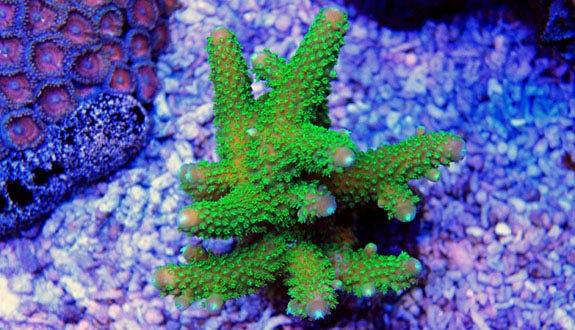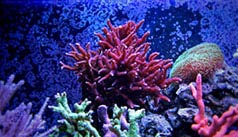

Alternative species (click on the thumbnail to see the card)
Names
Scientific name
Acropora spp.
Common name
Table coral
Elkhorn coral
Staghorn coral
Origin

Origin: South Pacific, Indian Ocean, Red Sea, Caribbean Sea
Kind

Kind: Hard coral with small polyps (SPS)
Form: its branches end in a polyp. This coral can be in the form of a tree or in the form of a tray
Group

Acroporidae
Volume

200 L / 44 imp gal / 53 US gal
Parameters

T°: 23 to 28°C or 73 to 82°F
pH: 7.8 to 8.5
Density: 1021 to 1028
Difficulty
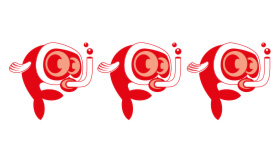
Hard
Size

1 m / 3.3 feet (width and height)
Brewing

Strong
Lighting

Strong
Aggressiveness

Low
Food
How to feed the Acropora?
Food
How to feed the Acropora?
Like many corals, the Acropora lives in symbiosis with a micro-algae (zooxanthella) which provides a large part of its food.
In addition, the coral will naturally deploy its polyps to capture zooplankton suspended in the water. Note that this activity is mainly nocturnal in this species. If necessary, do not hesitate to make a complementary contribution in microplanton.
Cohabitation
Who can live with the Acropora?
Cohabitation
Who can live with the Acropora?
There is predation by triggerfish, butterflyfish (Chaetodon) and filefish (Oxymonacanthus longirostris) on the Acropora. Their cohabitation is therefore impossible.
Acropora can be kept in the same aquarium as soft corals as long as they are not in direct contact with its stinging corals. Activated carbon filtration and a skimmer should also be installed so that there are no urticating particles suspended in the water (which could hinder the development of the Acropora).
The presence of this coral is desirable if you maintain yellow gobies (Gobiodon okinawae). Make sure that the foot is large enough.
Breeding
How to breed the Acropora?
Breeding
How to breed the Acropora?
It's quite easy to multiply this coral. You have the possibility either to recover the shoots at the base of the foot, or to divide it delicately, or by simply separating the colony. Stick the new colony on another rock.
With the right conditions, the colony will grow quickly, giving you beautiful colourful bouquets!
Its aquarium
Which aquarium for the Acropora?
Its aquarium
Which aquarium for the Acropora?
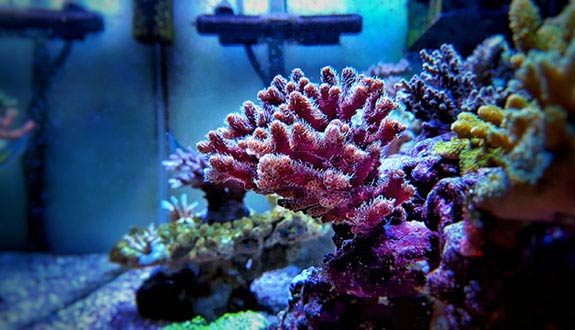
Install this type of coral rather in the upper part of your aquarium so that it can benefit from a good luminosity, essential for its development (HQI lamp mandatory). It will also be necessary to ensure that it is stirred in a relatively strong current.
Clear and good quality water (unpolluted) is also essential for Acroporas. The chemical parameters must be very stable. The most sensitive parameter is the pH (which must always be higher than 7), so you should check this regularly. A skimmer is also indispensable to filter the organic particles.cut. This can damage tissue and cause infection of the brown jelly.
Good To know
Find all additional information!
Good To know
Find all additional information!
In spite of its success in aquarium keeping (due to its many shapes and colours), Acroporas are quite difficult to maintain. Indeed, they are quite demanding in terms of water quality, light and current. You will therefore need some experience before you start maintaining this coral.
Even if their size in an aquarium may seem impressive to you, be aware that in the wild, Acropora colonies can measure more than 10 meters (33 feet) in diameter!
There are more than 170 different species of Acropora!
Acroporas are building corals: they participate in the creation of coral reefs.
In case of danger or the presence of a predator, the polyps can retreat into the coral.
The branches of the Acropora are short for species living in shallow water and long for deeper species.
Depending on the species, they can be red, pink, blue, purple, orange, yellow, green or brown.
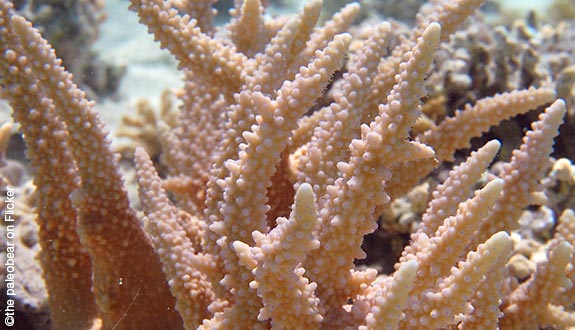
Yours photos!
Comments
Sort by:
Please login to post comments
